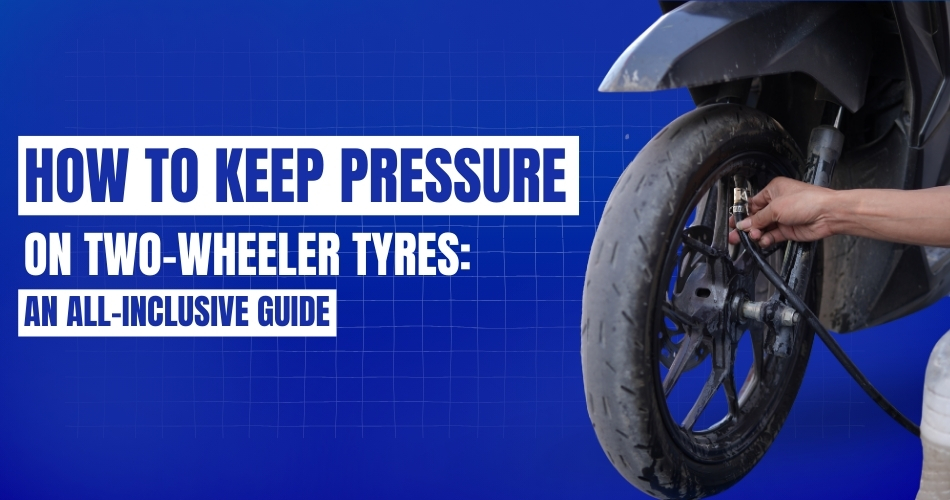Maintaining the best possible pressure in your tyres is important for the perfection of performance of your vehicle and for keeping you safe on the road. If it is a scooty, bike, or car, proper air pressure forms one of the most essential aspects for gaining the best possible fuel efficiency, preventing accidents, and ensuring the extended lifespan of tyres. This guide covers the importance of having the right tyre pressure for two-wheelers and cars, considering all the need-to-know basics of keeping your tyres in superb condition.
Why is Two-Wheeler Tyre Pressure Maintaining Important?
Be it a scooty tyre air pressure or bike tyre air pressure, many often leave the latter to be unchecked regularly. The wrong pressure in the tyres will affect your vehicle unevenly and cause a decrease in mileage, which in extreme cases can even cause a tyre burst. This would compromise the overall ride stability and handling of the vehicle, making it imperative to keep an eye on the two-wheeler air pressure regularly.
Tyres are the only contact that a two-wheeler makes with the ground, so proper pressure is the right way to go about it in order to optimize grip, stability, and ride comfort, be it on an Activa or any other two-wheeler. Proper air pressure cannot be more important than this.
Suggested Tyre Pressure of Various Two-Wheelers
Tyre pressure for all two wheelers, be it scooter or bike or motorcycle, is provided in the user manual accompanying that two-wheeler. Let’s just classify it into the commonly used varieties of two wheelers:
1. Scooty Air Pressure
Scooties will always demand lower pressure than that of a bicycle. Say, for two-stroke scooters such as Activa, it may have some pressure range both for single riding and pillion riding. Talking of the picture, one Activa suggests 20-22 PSI on the front and 26-29 PSI on the rear for solo ride. And for the pillion ride, the pressure on the rear tyre may have to be raised up to 32-36 PSI.
2. Two-Wheeler Tyre Pressure for Bikes
In a bike, due to a high speed, and frame weight, the pressure used by the tyres is more. The range of PSI for the normal bike tyre is 24-29 PSI for the front and 28-34 PSI for the rear depending on the model of the bike and whether you ride with a pillion or solo. The above image gives an idea about the differences in the PSI in different types of bikes.
This is yet another reason to check the correct pressure of the two-wheeler tyre for better fuel efficiency, as well as ensuring road safety, as over-inflated or under-inflated tyres can make the bike unstable, especially when it takes that sharp turn.
3. Activa Tyre Pressure
The Activa is probably one of the most used two-wheelers in India, which has a requirement for different tyre pressures. If the rider goes alone, then the PSI of the front tyres of an Activa should be kept at 20-22. And at the rear end, at 26-29 PSI. But if the rider has a pillion along with him, then keeping higher PSI at the rear end will be advisable at 32-36. This maintains a balance as well as grips on the road which eliminates all sorts of unnecessary wear.
Effects of Low Tyre Pressure
Incorrect air pressure may cause a series of problems:
Under-Inflation
Under-inflated tyres tend to cause overheating walls with flexing that increases the chances of tyre failure. Lower fuel efficiency, and fast wear along the edges.
Over-inflation:
This makes the ride unbearable for the inflated tires because tires tend to be over-hardened and thus prone to more severe damage from potholes. It would unevenly wear out the middle of the tire tread, which increases chances of losing traction to wet surfaces.
For both cases, maintaining the two-wheeler air pressure set by the manufacturer will exclude such complications and have longevity on your vehicle’s tires.
How Often to Examine the Air Pressure of Two Wheelers?
The inspection about the bike air pressure or scooty air pressure is done on a regular basis. It is suggested that the check up for the tyre pressure should be conducted every fortnight before a long ride. On checking the air pressure, ensure that your tires are cold and you are not on a run for long. This is because heating up causes air to swell up and provides false reading.
One will always be assured of riding with the right air pressure if they keep a digital or analog tyre pressure gauge handy. The person must ensure that they have good quality home access to a gauge and an air pump.
Tyre Pressure for Cars: A Brief Overview
Indeed, while the concentration here is on the two-wheeler, there comes to the general experience a parallel aspect associated with a car tyre pressure front and rear. Having wrong pressure in car tyres reduces its handling and braking capability besides bringing fuel efficiency down. The front and rear tyres of a car have different pressure requirements, given the distribution of weight in the vehicle. Thus, go through the user manual of your car and determine the recommended pressure values to be set for both your front and rear tyres.
How to Enjoy Long Lasting Tyres on Your Two Wheeler
While correct pressure is the backbone of a tire’s long life, here are more tips.
Regular Checks
Regularly check your tires for over wear, cracks, or puncture. Early identification will prevent you from facing grave issues
Tyre Balance and Alignment
Tyre balancing and alignment in its worst position will also affect your tyres badly. A regular wheel alignment and balancing ensures that is out of your control.
Avoid Overloading: Overloading your two-wheeler can stress the tyres, which may generate excessive tire wear. Just keep to the recommended load capacity.
Ride Smoothly: Aggressive braking, high-speed cornering, rapid acceleration are some of the ways through which tires wear faster. Smooth riding will surely prolong its life.
Conclusion
Maintaining the correct two-wheeler tyre pressure is very important and will enable you to have a safe and smooth ride. Whether it’s your scooty, bike, or car, make sure to check the air pressure regularly, inspect signs of wear and tear, and maintain your vehicle’s recommended tyre pressure. This way, you can ensure your safety and the lifespan of your tyres. Do not forget this crucial, yet easy-to-miss, aspect of vehicle maintenance.
Armed with the above information, you all are equipped with the right knowledge on keeping the front and rear car tyres of your scootys, bikes, and even cars in the most optimum pressure. Check them regularly, fine-tune them to make for a comfortable, safe ride to work, or to that long trip.

